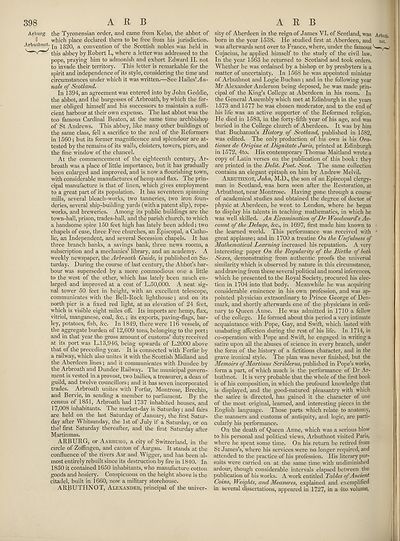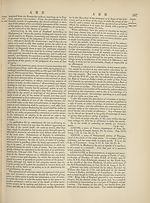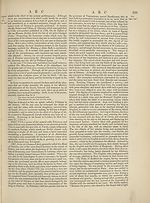Encyclopaedia Britannica > Volume 3, Anatomy-Astronomy
(406) Page 398
Download files
Complete book:
Individual page:
Thumbnail gallery: Grid view | List view

398 A K B
Arburg the Tyronensian order, and came from Kelso, the abbot of
II which place declared them to be free from his jurisdiction.
Arbuthnot. jn J320, a convention of the Scottish nobles was held in
this abbey by Robert I., where a letter was addressed to the
pope, praying him to admonish and exhort Edward II. not
to invade their territory. This letter is remarkable for the
spirit and independence of its style, considering the time and
circumstances under which it was written.—See Hailes’
iials of Scotland.
In 1394, an agreement was entered into by John Geddie,
the abbot, and the burgesses of Arbroath, by which the for¬
mer obliged himself and his successors to maintain a suffi¬
cient harbour at their own expense. The last abbot was the
too famous Cardinal Beaton, at the same time archbishop
of St Andrews. This abbey, like many other buildings of
the same class, fell a sacrifice to the zeal of the Reformers
in 1560; but its former magnificence and splendour are at¬
tested by the remains of its walls, cloisters, towers, piers, and
the fine window of the chancel.
At the commencement of the eighteenth century, Ar¬
broath was a place of little importance, but it has gradually
been enlarged and improved, and is now a flourishing town,
with considerable manufactures of hemp and flax. The prin¬
cipal manufacture is that of linen, which gives employment
to a great part of its population. It has seventeen spinning
mills, several bleach-works, two tanneries, two iron foun-
deries, several ship-building yards (with a patent slip), rope-
works, and breweries. Among its public buildings are the
town-hall, prison, trades-hall, and the parish church, to which
a handsome spire 150 feet high has lately been added; two
chapels of ease, three Free churches, an Episcopal, a Catho¬
lic, an Independent, and several Secession chapels. It has
three branch banks, a savings bank, three news rooms, a
subscription and a mechanics’ library, and an academy. A
weekly newspaper, the Arbroath Guide, is published on Sa¬
turday. During the course of last century, the Abbot’s har¬
bour was superseded by a more commodious one a little
to the west of the other, which has lately been much en¬
larged and improved at a cost of L.50,000. A neat sig¬
nal tower 50 feet in height, with an excellent telescope,
communicates with the Bell-Rock lighthouse; and on its
north pier is a fixed red light, at an elevation of 24 feet,
which is visible eight miles off. Its imports are hemp, flax,
vitriol, manganese, coal, &c.; its exports, paving-flags, bar¬
ley, potatoes, fish, &c. In 1849, there were 116 vessels, of
the aggregate burden of 12,609 tons, belonging to the port;
and in that year the gross amount of customs’ duty received
at its port was L.l 3,946, being upwards of L.2000 above
that of the preceding year. It is connected with Forfar by
a railway, which also unites it with the Scottish Midland and
the Aberdeen lines; and it communicates with Dundee by
the Arbroath and Dundee Railway. The municipal govern¬
ment is vested in a provost, two bailies, a treasurer, a dean of
guild, and twelve councillors; and it has seven incorporated
trades. Arbroath unites with Forfar, Montrose, Brechin,
and Bervie, in sending a member to parliament. By the
census of 1851, Arbroath had 1737 inhabited houses, and
17,008 inhabitants. The market-day is Saturday; and fairs
are held on the last Saturday of January, the first Satur¬
day after Whitsunday, the 1st of July if a Saturday, or on
thel first Saturday thereafter, and the first Saturday after
Martinmas.
ARBURG, or Aarburg, a city of Switzerland, in the
circle of Zoffingen, and canton of Aargau. It stands at the
confluence of the rivers Aar and Wigger, and has been al¬
most entirely rebuilt since its destruction by fire in 1840. In
1850 it contained 1650 inhabitants, who manufacture cotton
goods and hosiery. Conspicuous on the height above is the
citadel, built in 1660, now a military storehouse.
ARBUTHNOT, Alexander, principal of the univer-
A R B
sity of Aberdeen in the reign of James VI. of Scotland, was Arbuth.
born in the year 1538. He studied first at Aberdeen, and not.
was afterwards sent over to France, where, under the famous
Cujacms, he applied himself to the study of the civil law.
In the year 1563 he returned to Scotland and took orders.
Whether he was ordained by a bishop or by presbyters is a
matter of uncertainty. In 1568 he was appointed minister
of Arbuthnot and Logie Buchan ; and in the following year
Mr Alexander Anderson being deposed, he was made prin¬
cipal of the King’s College at Aberdeen in his room. In
the General Assembly which met at Edinburgh in the years
1573 and 1577 he was chosen moderator, and to the end of
his life was an active supporter of the Reformed religion.
He died in 1583, in the forty-fifth year of his age, and was
buried in the College church of Aberdeen. It was by him
that Buchanan’s History of Scotland, published in 1582,
was edited. The only production of his own is his Ora-
tiones de Origins et LHgnitate Juris, printed at Edinburgh
in 1572, 4to. His contemporary Thomas Maitland wrote a
copy of Latin verses on the publication of this book: they
are printed in the Delit. Poet. Scot. The same collection
contains an elegant epitaph on him by Andrew Melvil.
Arbuthnot, John, M.D., the son of an Episcopal clergy¬
man in Scotland, was born soon after the Restoration, at
Arbuthnot, near Montrose. Having gone through a course
of academical studies and obtained the degree of doctor of
physic at Aberdeen, he went to London, where he began
to display his talents in teaching mathematics, in which he
was well skilled. An Examination of Dr Woodward's Ac¬
count of the Deluge, See., in 1697, first made him known to t
the learned world. This performance was received with '
great applause; and in 1700 a treatise On the Usefulness of
Mathematical Learning increased his reputation. A very
interesting paper On the Regularity of the Births of both
Sexes, demonstrating from authentic proofs the universal
similarity which is observed by nature in this circumstance,
and drawing from these several political and moral inferences,
which he presented to the Royal Society, procured his elec¬
tion in 1704 into that body. Meanwhile he was acquiring
considerable eminence in his own profession, and was ap¬
pointed physician extraordinary to Prince George of Den¬
mark, and shortly afterwards one of the physicians in ordi¬
nary to Queen Anne. He was admitted in 1710 a fellow
of the college. He formed about this period a very intimate
acquaintance with Pope, Gay, and Swift, which lasted with
unabating affection during the rest of his life. In 1714, in
co-operation with Pope and Swift, he engaged in writing a
satire upon all the abuses of science in every branch, under
the form of the history of a fictitious character, and in the
grave ironical style. The plan was never finished, but the
Memoirs of Martinus Scriblerus, published in Pope’s works,
form a part, of which much is the performance of Dr Ar¬
buthnot. It is very probable that the whole of the first book
is of his composition, in which the profound knowledge that
is displayed, and the good-natured pleasantry with which
the satire is directed, has gained it the character of one
of the most original, learned, and interesting pieces in the
English language. Those parts which relate to anatomy,
the manners and customs of antiquity, and logic, are parti¬
cularly his performance.
On the death of Queen Anne, which was a serious blow
to his personal and political views, Arbuthnot visited Paris,
where he spent some time. On his return he retired from
St James’s, where his services were no longer required, and
attended to the practice of his profession. His literary pur¬
suits were carried on at the same time with undiminished
ardour, though considerable intervals elapsed between the
publication of his wmrks. A work entitled Tables of Ancient
Coins, Weights, and Measures, explained and exemplified
in several dissertations, appeared in 1727, in a 4to volume,
J
Arburg the Tyronensian order, and came from Kelso, the abbot of
II which place declared them to be free from his jurisdiction.
Arbuthnot. jn J320, a convention of the Scottish nobles was held in
this abbey by Robert I., where a letter was addressed to the
pope, praying him to admonish and exhort Edward II. not
to invade their territory. This letter is remarkable for the
spirit and independence of its style, considering the time and
circumstances under which it was written.—See Hailes’
iials of Scotland.
In 1394, an agreement was entered into by John Geddie,
the abbot, and the burgesses of Arbroath, by which the for¬
mer obliged himself and his successors to maintain a suffi¬
cient harbour at their own expense. The last abbot was the
too famous Cardinal Beaton, at the same time archbishop
of St Andrews. This abbey, like many other buildings of
the same class, fell a sacrifice to the zeal of the Reformers
in 1560; but its former magnificence and splendour are at¬
tested by the remains of its walls, cloisters, towers, piers, and
the fine window of the chancel.
At the commencement of the eighteenth century, Ar¬
broath was a place of little importance, but it has gradually
been enlarged and improved, and is now a flourishing town,
with considerable manufactures of hemp and flax. The prin¬
cipal manufacture is that of linen, which gives employment
to a great part of its population. It has seventeen spinning
mills, several bleach-works, two tanneries, two iron foun-
deries, several ship-building yards (with a patent slip), rope-
works, and breweries. Among its public buildings are the
town-hall, prison, trades-hall, and the parish church, to which
a handsome spire 150 feet high has lately been added; two
chapels of ease, three Free churches, an Episcopal, a Catho¬
lic, an Independent, and several Secession chapels. It has
three branch banks, a savings bank, three news rooms, a
subscription and a mechanics’ library, and an academy. A
weekly newspaper, the Arbroath Guide, is published on Sa¬
turday. During the course of last century, the Abbot’s har¬
bour was superseded by a more commodious one a little
to the west of the other, which has lately been much en¬
larged and improved at a cost of L.50,000. A neat sig¬
nal tower 50 feet in height, with an excellent telescope,
communicates with the Bell-Rock lighthouse; and on its
north pier is a fixed red light, at an elevation of 24 feet,
which is visible eight miles off. Its imports are hemp, flax,
vitriol, manganese, coal, &c.; its exports, paving-flags, bar¬
ley, potatoes, fish, &c. In 1849, there were 116 vessels, of
the aggregate burden of 12,609 tons, belonging to the port;
and in that year the gross amount of customs’ duty received
at its port was L.l 3,946, being upwards of L.2000 above
that of the preceding year. It is connected with Forfar by
a railway, which also unites it with the Scottish Midland and
the Aberdeen lines; and it communicates with Dundee by
the Arbroath and Dundee Railway. The municipal govern¬
ment is vested in a provost, two bailies, a treasurer, a dean of
guild, and twelve councillors; and it has seven incorporated
trades. Arbroath unites with Forfar, Montrose, Brechin,
and Bervie, in sending a member to parliament. By the
census of 1851, Arbroath had 1737 inhabited houses, and
17,008 inhabitants. The market-day is Saturday; and fairs
are held on the last Saturday of January, the first Satur¬
day after Whitsunday, the 1st of July if a Saturday, or on
thel first Saturday thereafter, and the first Saturday after
Martinmas.
ARBURG, or Aarburg, a city of Switzerland, in the
circle of Zoffingen, and canton of Aargau. It stands at the
confluence of the rivers Aar and Wigger, and has been al¬
most entirely rebuilt since its destruction by fire in 1840. In
1850 it contained 1650 inhabitants, who manufacture cotton
goods and hosiery. Conspicuous on the height above is the
citadel, built in 1660, now a military storehouse.
ARBUTHNOT, Alexander, principal of the univer-
A R B
sity of Aberdeen in the reign of James VI. of Scotland, was Arbuth.
born in the year 1538. He studied first at Aberdeen, and not.
was afterwards sent over to France, where, under the famous
Cujacms, he applied himself to the study of the civil law.
In the year 1563 he returned to Scotland and took orders.
Whether he was ordained by a bishop or by presbyters is a
matter of uncertainty. In 1568 he was appointed minister
of Arbuthnot and Logie Buchan ; and in the following year
Mr Alexander Anderson being deposed, he was made prin¬
cipal of the King’s College at Aberdeen in his room. In
the General Assembly which met at Edinburgh in the years
1573 and 1577 he was chosen moderator, and to the end of
his life was an active supporter of the Reformed religion.
He died in 1583, in the forty-fifth year of his age, and was
buried in the College church of Aberdeen. It was by him
that Buchanan’s History of Scotland, published in 1582,
was edited. The only production of his own is his Ora-
tiones de Origins et LHgnitate Juris, printed at Edinburgh
in 1572, 4to. His contemporary Thomas Maitland wrote a
copy of Latin verses on the publication of this book: they
are printed in the Delit. Poet. Scot. The same collection
contains an elegant epitaph on him by Andrew Melvil.
Arbuthnot, John, M.D., the son of an Episcopal clergy¬
man in Scotland, was born soon after the Restoration, at
Arbuthnot, near Montrose. Having gone through a course
of academical studies and obtained the degree of doctor of
physic at Aberdeen, he went to London, where he began
to display his talents in teaching mathematics, in which he
was well skilled. An Examination of Dr Woodward's Ac¬
count of the Deluge, See., in 1697, first made him known to t
the learned world. This performance was received with '
great applause; and in 1700 a treatise On the Usefulness of
Mathematical Learning increased his reputation. A very
interesting paper On the Regularity of the Births of both
Sexes, demonstrating from authentic proofs the universal
similarity which is observed by nature in this circumstance,
and drawing from these several political and moral inferences,
which he presented to the Royal Society, procured his elec¬
tion in 1704 into that body. Meanwhile he was acquiring
considerable eminence in his own profession, and was ap¬
pointed physician extraordinary to Prince George of Den¬
mark, and shortly afterwards one of the physicians in ordi¬
nary to Queen Anne. He was admitted in 1710 a fellow
of the college. He formed about this period a very intimate
acquaintance with Pope, Gay, and Swift, which lasted with
unabating affection during the rest of his life. In 1714, in
co-operation with Pope and Swift, he engaged in writing a
satire upon all the abuses of science in every branch, under
the form of the history of a fictitious character, and in the
grave ironical style. The plan was never finished, but the
Memoirs of Martinus Scriblerus, published in Pope’s works,
form a part, of which much is the performance of Dr Ar¬
buthnot. It is very probable that the whole of the first book
is of his composition, in which the profound knowledge that
is displayed, and the good-natured pleasantry with which
the satire is directed, has gained it the character of one
of the most original, learned, and interesting pieces in the
English language. Those parts which relate to anatomy,
the manners and customs of antiquity, and logic, are parti¬
cularly his performance.
On the death of Queen Anne, which was a serious blow
to his personal and political views, Arbuthnot visited Paris,
where he spent some time. On his return he retired from
St James’s, where his services were no longer required, and
attended to the practice of his profession. His literary pur¬
suits were carried on at the same time with undiminished
ardour, though considerable intervals elapsed between the
publication of his wmrks. A work entitled Tables of Ancient
Coins, Weights, and Measures, explained and exemplified
in several dissertations, appeared in 1727, in a 4to volume,
J
Set display mode to:
![]() Universal Viewer |
Universal Viewer | ![]() Mirador |
Large image | Transcription
Mirador |
Large image | Transcription
Images and transcriptions on this page, including medium image downloads, may be used under the Creative Commons Attribution 4.0 International Licence unless otherwise stated. ![]()
| Encyclopaedia Britannica > Encyclopaedia Britannica > Volume 3, Anatomy-Astronomy > (406) Page 398 |
|---|
| Permanent URL | https://digital.nls.uk/193762626 |
|---|
| Attribution and copyright: |
|
|---|---|
| Shelfmark | EB.16 |
|---|---|
| Description | Ten editions of 'Encyclopaedia Britannica', issued from 1768-1903, in 231 volumes. Originally issued in 100 weekly parts (3 volumes) between 1768 and 1771 by publishers: Colin Macfarquhar and Andrew Bell (Edinburgh); editor: William Smellie: engraver: Andrew Bell. Expanded editions in the 19th century featured more volumes and contributions from leading experts in their fields. Managed and published in Edinburgh up to the 9th edition (25 volumes, from 1875-1889); the 10th edition (1902-1903) re-issued the 9th edition, with 11 supplementary volumes. |
|---|---|
| Additional NLS resources: |
|

